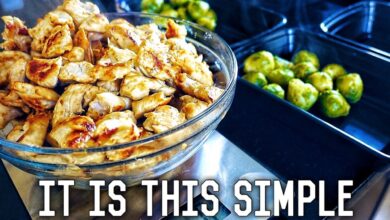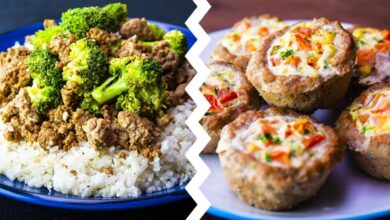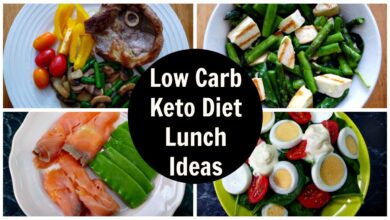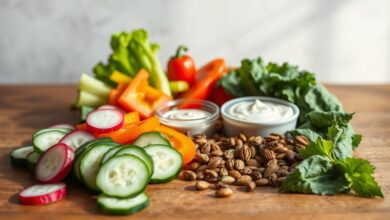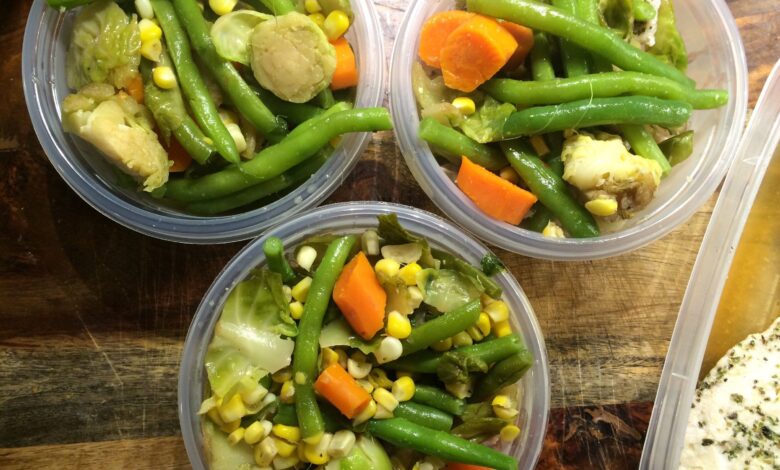
If you’ve ever stared into your fridge on Sunday evening thinking “What can I prep this week that’s healthy, low-carb and actually tastes good?”, you’re in the right spot. Meal prepping doesn’t have to mean bland chicken and boring broccoli. In fact, with the right cornerstone items, you can build vibrant, flavor-packed, low-carb meals that keep you fueled and satisfied. In this guide I’ll walk you through six must-have ingredients that form the backbone of any successful low-carb meal prep strategy—and I’ll show you how to use them, why they work, and how they fit into real-life rhythms (whether you’re in Accra, New York or London). Let’s jump in.
Read Also 5 Easy Low-Carb Meal Prep Recipes for Weight Loss That Work Everywhere
Why low-carb meal prep matters
You might wonder: “Is meal prep really necessary?” or “Why low-carb?” Well, think of your weekly eating plan like a building: if you build on a shaky foundation, the whole thing wobbles. Meal prep gives you structure, and choosing low-carb options helps you keep blood sugar steady, reduce energy dips, and feel in control. Studies show low-carb meals can simplify diet management for busy lives. (Healthline) And in the meal-prep world, the right ingredients make all the difference—they’re your bricks, beams and mortar.
How to choose the right ingredients
Before we list our six key ingredients, let’s talk criteria. What makes an ingredient “must-have” for low-carb meal prep?
- Low in digestible carbs, so you stay within your target without feeling deprived. (Healthline)
- Versatile, meaning you can use it across multiple meals, days and meal styles (breakfast, lunch, dinner, snack).
- Satisfying, offering either protein, healthy fat or fiber—because low-carb does not mean low-taste or low-satiety.
- Accessible globally, since whether you’re in Ghana, the US, or Europe, you want ingredients you can source without breaking the bank.
- Prep-friendly, meaning they store well, reheat well (if needed), and let you build meal containers without stress.
With those criteria in mind, here are the six ingredients you’ll want to stock now.
1. Cauliflower (or its rice/“rice-substitute” form)
Cauliflower is the unsung hero of low-carb meal prep. It gives you a rice-like base with minimal carbs, plenty of fiber and the flexibility to pair with almost anything. For instance, swapping standard rice for cauliflower rice can cut carb load dramatically. (Food Network)
Why it works:
- Low in net carbs, high in volume.
- Neutral flavor—so you can season it boldly (garlic, herbs, spices) or treat it like mashed or riced portions.
- Pre-cut florets or frozen versions make prep easy.
- It takes on whatever flavor your other components bring—so your spice mix, sauce or protein shine.
How to use it:
- Make a big batch of cauliflower rice on Sunday. Sauté with olive oil, garlic and seasonings; portion into containers.
- Use it as a base for bowls: protein + cauliflower rice + veggies + sauce.
- Make “rice-free” sides: e.g., cauliflower mash instead of mashed potatoes.
- Store cooked in the fridge for up to 4 days; freeze extra portions.
Tip for Ghana/West Africa + US/Europe:
You might find frozen cauliflower rice inexpensive in supermarkets. In Ghana, if frozen options are limited, buy fresh cauliflower and process it yourself (food processor or grated) and store in sealed bags. Makes local sense.
2. Leafy greens & colorful non-starchy vegetables
Think spinach, kale, Swiss chard, mixed salad leaves, bell peppers, zucchini. These veggies give color, micronutrients and fiber without piling on the carbs. According to nutritional frameworks, non-starchy vegetables are foundational in low-carb patterns. (Food Network)
Why they matter:
- They provide bulk so you feel full but stay well under carb thresholds.
- Great for micronutrient density: vitamins, minerals and antioxidants.
- Versatility: raw (salads), sautéed, roasted or steamed.
- They brighten the meal, which boosts satisfaction — we eat with our eyes first.
How to integrate them:
- Sunday prep: wash, chop and store greens and peppers in containers.
- Use them as layers in your containers: base of greens, then protein, then vegetable side.
- Set aside a “mix” of roasted veggies (you could roast zucchini, peppers, mushrooms) for grab-and-go.
- Use leafy greens as wraps (lettuce wraps) instead of bread, for a low-carb sandwich alternative.
Pro tip:
If you’re travelling between climates (West Africa’s heat vs cooler US/Europe), opt for sturdy greens like kale or chard that last better than delicate lettuces.
3. High-quality protein source (chicken breast, turkey, fish, eggs)
Low-carb meals lean heavily on protein—not just for muscle or weight goals, but because protein stabilizes hunger, supports recovery and keeps you satisfied. Many low-carb meal-prep articles highlight this. (Berry Street)
Key reasons to include it:
- Protein intake supports lean body composition and helps keep metabolism active.
- It pairs with low-carb vegetables to form balanced meals (protein + veggie + smart carb substitute).
- It reheats well (especially chicken, turkey, fish) so works for prepping ahead.
Best options & how to prep:
- Chicken breast: bake or grill with simple seasoning (salt, pepper, paprika, garlic).
- Turkey mince or breast: quick stir-fry with veggies.
- Fish (e.g., salmon or tilapia): oven bake, portion, and use for bowls.
- Eggs: boiled or made into an egg-muffin batch; perfect for a quick breakfast or snack.
Regional tip:
In Ghana/West Africa: you might source local fish (tilapia, mackerel) at good value. Use these as your protein option. In the US/Europe: bulk buy chicken or frozen fish fillets to reduce cost and increase prep efficiency.
4. Healthy fats (avocado, nuts/seeds, olive oil, coconut oil)
Often when people think “low-carb” they forget the importance of good-quality fat. It’s not just about chopping carbs—it’s about providing your body with energy and satiety from fat. Many low-carb frameworks emphasize healthy fats as a core component. (Food Network)
Why healthy fats are vital:
- They help you feel full and keep energy levels steady.
- They support absorption of fat-soluble vitamins (A, D, E, K) from your veggies.
- They add flavor and richness to meals, which makes your prep feel indulgent rather than restrictive.
How to include them:
- Drizzle just-cooked veggies or proteins with extra virgin olive oil.
- Add slices of avocado to your bowls or salad containers.
- Keep a snack bag of mixed nuts/seeds (almonds, walnuts, pumpkin seeds) for on-the-go.
- Use coconut oil for cooking if you like a slight tropical flavor—especially relevant if you’re in West Africa and have access to fresh coconuts.
Pro tip:
Mind portion size for nuts/seeds because while they’re healthy, they’re calorie-dense. For example, a small handful (~30 g) is plenty.
5. Spices, herbs and condiments (sugar-free sauces, vinegars, garlic, ginger)
This might seem “extra”, but in meal prep it’s essential. A bland container full of chicken and greens? It’ll end up untouched or swapped for take-out. The right flavor enhancers turn your meal-prep containers into something you actually look forward to eating. In fact, one article on low-carb meal prep emphasizes relying on staples like oils, vinegar and condiments to keep variety going. (The Kitchn)
Why this category matters:
- Flavor prevents meal-prep fatigue (when you’re sick of eating the same thing).
- Herbs/spices often carry health-benefits (e.g., turmeric, ginger) and little to no carbs.
- Smart condiments can add sweetness, tang or heat without sugar or starch.
How to stock and use them:
- Have a base set of seasonings: salt, pepper, garlic powder, paprika, cumin, chili flakes.
- Keep fresh herbs (or dried) handy: parsley, cilantro, basil, thyme.
- Use vinegar (apple cider, wine vinegar) for dressings and tang.
- Use sugar-free sauces (check labels) or make your own: e.g., Greek-yogurt-base dressing, or a squeeze of lime with a dash of sesame oil.
- Rotate flavor profiles: Mediterranean one week (olive oil, oregano), Asian next (ginger, soy sauce alternative), African next (spiced peanut sauce, chili powder) to keep things exciting.
6. Meal-prep friendly containers & storage foundations
Ok, this one isn’t a food ingredient. But think of it as the infrastructure ingredient. Without proper containers, compartments, and storage workflow, even the best foods will lose their impact. Meal prep is as much about organization as it is about ingredients. Many low-carb meal-prep systems emphasize efficient storage. (Sweet Peas and Saffron)
Why containers & storage matter:
- They determine how fresh your meals stay (airtight containers keep veggies crisp, proteins safe).
- They influence portion control (having uniform containers means you know exactly what a “meal” looks like).
- They support your busy schedule (grab-and-go means less decision fatigue).
- They reduce waste (if you plan well you reduce spoilage and save money).
What to consider:
- Choose BPA-free, microwave/reheat safe containers if you’ll heat.
- Consider portion size: maybe 600-800 ml containers for lunch, smaller for breakfast/snacks.
- Get lids that seal well.
- Label date and contents if you prep multiple days ahead.
- If freezing, get freezer-safe containers.
- Establish a Sunday or mid-week “prep session” where you cook, portion and store.
Local tip:
In Ghana you might want to select durable containers that can stand a bit of heat and humidity. In US/Europe, you’ll find more specialty containers, but the principle is the same.
Putting it all together: Sample weekly low-carb meal-prep plan
Let’s translate those six ingredients into a practical framework. Use cauliflower rice + leafy greens + protein + healthy fats + flavorful condiments, all stored properly. Here’s how a week might look.
Sunday prep session (1–2 hours)
- Cook 4 chicken breasts (seasoned).
- Roast a tray of mixed non-starchy vegetables (zucchini, bell peppers, mushrooms).
- Sauté a large batch of cauliflower rice with garlic and herbs.
- Wash and chop leafy greens, bell peppers, maybe carrots for crunch (though carrots higher in carbs so moderate).
- Portion out containers: base of greens, then roasted veggies, then chicken; alternate with bowls of cauliflower rice, veggies, protein.
- Portion nuts/seeds into snack bags.
- Drizzle olive oil or store tiny containers of dressing for each meal.
- Label and date the containers; refrigerate what you’ll eat in the next 3–4 days, freeze the rest.
Meals might look like this:
- Monday lunch: Cauliflower rice + roasted veggies + grilled chicken + slice of avocado + sprinkle of nuts + vinaigrette.
- Tuesday lunch: Leafy-greens salad + chicken strips + chopped bell peppers + pumpkin seeds + olive oil/lemon dressing.
- Wednesday lunch: Salmon (or alternate protein) + cauliflower rice + sautéed greens + dollop of Greek yogurt sauce.
- Thursday lunch: Turkey mince stir-fry with vegetables + cauliflower base.
- Friday lunch: Leftover veggies + chicken + small handful of nuts + fresh herbs + light dressing.
Variations:
- Breakfasts could be egg-muffins (eggs + spinach + pepper) or boiled eggs + avocado + nuts.
- Snacks: nuts/seeds + maybe a piece of cheese + raw veggie sticks.
- Dinner: use same ingredient pool but change cooking style—grill instead of roast, stew instead of sauté.
The beauty of this setup is that you’re not constantly reinventing the wheel. You’re working with six reliable ingredients (plus herbs/spices) and leaving the rest of the week’s decisions easy.
Common mistakes and how to avoid them
Meal prep sounds great, but there are pitfalls—especially when you’re aiming for low-carb. Let’s tackle some common mistakes and how to sidestep them.
Mistake #1: Carbing out unintentionally
Sometimes you think “I’ll just add rice or bread” and your “low-carb” meal becomes moderate or high-carb. The fix: keep your substitution arsenal lean. Cauliflower rice or large leafy-green bases. Make that your standard.
Mistake #2: Meal-prep fatigue
Eating the exact same thing every day leads to burnout. Use your spices/herbs/condiment arsenal to vary flavor profiles. For example: Monday Mediterranean style, Wednesday Asian style, Friday African style with local spices and sauces.
Mistake #3: Poor storage leads to soggy/boring meals
If your veggies get soggy or your protein dries out, you’ll ditch your prep. Solution: choose the right containers, store components separately if ideal (e.g., dressings on the side), and schedule mid-week refreshes (like sauté fresh greens or add fresh herbs before eating).
Mistake #4: Ignoring portions
Low-carb doesn’t mean “eat unlimited”. Healthy fats are calorie-dense; even vegetables add up. Use your containers to gauge portion size, and listen to your hunger/satiety cues.
Mistake #5: Giving up when you hit a busy week
This is where the “infrastructure ingredient” (containers/storage) and material front-load pay off. Even in busy weeks you’ll have pre-made lunches ready so you don’t resort to high-carb convenience meals.
How to adapt for different goals or regions
Whether you’re in Ghana, the United States or Europe, your goal may differ (weight loss, muscle building, energy sustain). The good news: the six ingredients still apply—they just scale differently.
For weight-loss focus
- Keep protein moderate to high, fat moderate, carbs minimal (from veggies).
- Use smaller containers (~500 ml) so portions are more controlled.
- For fats, focus on things like avocado or olive oil rather than large handfuls of nuts.
For muscle-building or high-activity
- You can slightly increase portion size of protein and healthy fats.
- Maybe include a slightly higher portion of cauliflower rice (or alternatively sweet potato if you tolerate more carbs).
- Use your storage system to prep large batches so you’re ready post-workout meals.
Regional adaptation (Africa, US, Europe)
- In West Africa: local fish, tilapia, hearty greens (e.g., kale, cassava leaves) can be incorporated. Use coconut oil or palm oil in moderation (healthy fats) and local spices for flavor.
- In US/Europe: access to frozen veggies, protein bundles, specialty containers may make the system easier. But the same logic holds—volume of vegetables, base of low-carb substitute (cauliflower), strong protein, good fats, vibrant flavoring.
Pro tips for sustainability & success
Here are some final tips to help your low-carb meal prep not just work for a week, but become a sustainable habit:
- Set a consistent prep -day/time: pick a time each week when you’ll cook and portion. Habit matters.
- Use a visual checklist: ensure you’ve got your six base ingredients (cauliflower rice, vegetables, protein, greens, healthy fats, flavor pack/containers) either pre-bought or prepped before you cook.
- Rotate your flavor profiles: pick a theme each week (Mediterranean / African / Asian / Latin) and apply it to your seasons and dressings. This keeps things interesting and supports retention.
- Do a mid-week refresh: sometimes by day 4 your containers feel stale. Re-chop fresh salad greens, add new herbs or re-roast a tray of veggies to keep things fresh.
- Monitor how you feel: note how your energy, hunger levels and performance are across the week. If you feel low energy, maybe increase activity-friendly protein or tweak your fat portion.
- Budget smart: bulk buy proteins, use seasonal local vegetables, compare frozen vs fresh where appropriate. The six-ingredient framework helps manage cost.
- Stay fluid: If an ingredient isn’t available, substitute something equivalent (e.g., sweet potato vs cauliflower rice—just adjust portion size if higher in carbs).
Recap: Your six cornerstone ingredients
Let’s summarize for quick reference:
- Cauliflower (rice or mash substitute) – low carbs, high flexibility
- Leafy greens & non-starchy veggies – volume, micronutrients, satisfaction
- High-quality protein (chicken/turkey/fish/eggs) – satiety, lean muscle, structure
- Healthy fats (avocado, nuts/seeds, olive/coconut oil) – fullness, flavor, nutrient absorption
- Spices/herbs & smart condiments – flavor, variety, keeps you engaged
- Meal-prep containers & storage system – infrastructure that makes everything possible
These aren’t “nice-to-haves”—they’re foundational. You build your weekly meals around them, and the rest (variety, creativity, local twist) flows from there.
Why this works long-term
This approach works because it aligns with human psychology (we like variety, flavor and convenience) and nutritional science (low-carb patterns emphasize protein, healthy fats, low refined carbs). Studies of low-carb meal prep cite that fewer ingredients, simple substitutions, and planning ahead reduce decision fatigue and improve adherence. (Healthline)
It also works in global contexts. Whether you’re prepping in Accra or Chicago, having a streamlined set of ingredients you trust allows you to adapt to local markets and schedules. You’re not chasing “exotic” items—you’re using smart, dependable ones.
What to do next
If you’re ready to start:
- Open your fridge and pantry. Check: do you have cauliflower (or can you buy it this week)? Do you have greens, protein options, healthy fats, flavor stash and containers?
- Make a shopping list: pick the missing items.
- Schedule your prep session (e.g., Sunday 4 pm–6 pm).
- Choose two flavor themes for the week to keep variety.
- Prep everything, portion it out, store it—and you’re ready.
Within one week you’ll feel the difference: fewer eating decisions, more control, fewer carb crashes, and meals you enjoy.
Conclusion
Meal prepping for a low-carb lifestyle doesn’t have to be complicated or expensive. By anchoring your plan around six must-have ingredients—cauliflower rice, leafy greens & non-starchy veggies, high-quality protein, healthy fats, flavor boosters (spices/herbs/condiments), and a reliable storage system—you set yourself up for success. Whether you’re planning for weight-loss, muscle-maintenance, or simply wanting more consistent energy through your week, this framework is versatile and global. And best of all: it frees you from thinking “What do I eat today?” every single day. Instead, you prepare ahead, grab with confidence, and enjoy meals that support your goals—without the carb overload or boredom. Ready to build your week? Let’s go!
Read Also 5 Easy Low-Carb Meal Prep Recipes for Weight Loss That Work Everywhere
Frequently Asked Questions
Q1: Can I include some carbohydrates like rice or potatoes while still using this framework?
Yes—if your goals allow for moderate carbs, you can include small portions of higher-carb foods like sweet potato or brown rice. The key is balance: treat them as side elements, not bulk staples, and adjust portion sizes accordingly. The six-ingredient framework still applies—just substitute one of your “base carb replacements” occasionally rather than always relying on cauliflower.
Q2: How long will the meal-prepped containers stay fresh?
Typically, cooked proteins and veggies stored in airtight containers in the fridge will stay good for about 3-4 days. Beyond that, texture and flavor may start to degrade. If you prep for a full week, consider freezing a few portions and thawing mid-week. The container/storage component (#6) is critical to keeping freshness.
Q3: What if I’m vegetarian or vegan—can I still use this plan?
Absolutely. Swap the high-quality protein ingredient (point #3) for vegetarian/vegan options: tofu, tempeh, lentils (though lentils have more carbs so adjust), chickpeas (again adjust), or meat-substitutes. Use cauliflower rice, leafy greens, healthy fats and flavor profiles just the same. The core logic remains.
Q4: I travel a lot or my schedule is erratic—how can I make this flexible?
If you’re on the move, prioritize items that store and travel well: cooked proteins that reheat easily, sturdy vegetables, nuts/seeds for snacks, and portable containers. You might prep fewer containers at home and supplement with “on-the-go” low-carb options (e.g., salad + grilled chicken from a café). The key is consistency, not perfection.
Q5: How do I know how many portions I should prepare?
Start by assessing how many meals you’ll need for the coming week (e.g., five lunches, two dinners) and prep accordingly. Use uniform container sizes so you get visual consistency. Track your hunger and fullness—if you consistently feel under-fueled, increase portions of protein or healthy fat. If you feel too full, reduce. Tailor the volume to your goals (weight-loss vs maintenance vs muscle-gain) and energy needs.

